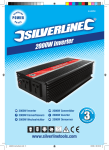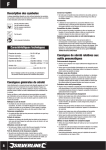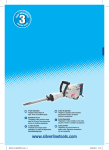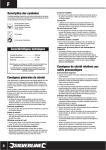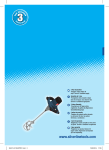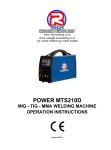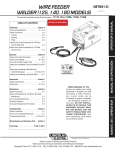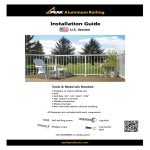Download User's Manual Turbo Mig 130 Gasless
Transcript
® Thankyou for choosing this product Silverline Tools 3 Year Guarantee • This guarantee becomes effective at the date of retail purchase. PLEASE KEEP YOUR RECEIPT. • If this product develops a fault within 30 days of purchase, return it to the stockist where it was purchased, with your receipt, stating details of the fault. You will receive a replacement or refund. • If this product develops a fault within 3 years of purchase return it to; Silverline Tools Service Centre PO Box 2988 Yeovil BA21 1WU Include your original receipt, details of the fault, your name and address, place and date of purchase. We do not refund carriage. All product should be in a suitably clean and safe state for repair, and should be packaged carefully to prevent damage or injury during transportation. We may reject unsuitable or unsafe deliveries. • You must provide proof of purchase before any work can be carried out. • All work will be carried out by Silverline Tools or its authorised repair agents. • Any parts which are replaced will become the property of Silverline Tools. • The repair or replacement of the product will not extend the period of guarantee. • The repair or replacement of your product under guarantee provides benefits which are additional to and do not affect your statutory rights as a consumer. What is covered: • The repair of the product, if found to be defective due to faulty materials or workmanship within 3 years of purchase. If any part is no longer available or out of manufacture, Silverline Tools will replace it with a functional replacement part. • Use of the product in the UK. What is not covered: Silverline Tools does not guarantee repairs required as a result of: • Normal wear and tear Eg blades, brushes, belts, bulbs, batteries etc. • Accidental damage, faults caused by negligent use or care, misuse, neglect, careless operation or handling of the product. • Use of the product for anything other than normal domestic purposes. • Change or modification of the product in any way. • Use of parts and accessories which are not Silverline Tools genuine components. • Faulty installation (except installed by Silverline Tools). • Repairs or alterations carried out by parties other than Silverline Tools or its authorised repair agents. User’s Manual Turbo Mig 130 Gasless Product Code 427677 © March 2008 Introduction Carefully read and understand this manual and any label attached to the tool before use. Keep these instructions with the product for future reference. Ensure all persons who use and service this product are acquainted with this manual. Electrical Safety Information • The wires in this product are coloured: Blue Neutral (N) Brown Live (L) Green & Yellow Earth (E) N BLUE (Neutral) E L FUSE L FUSE GREEN/YELLOW OR GREEN N BROWN (Live) Double Insulated BLUE (Neutral) FUSE FUSE E BROWN (Live) Earthed • As the colours may not correspond with the coloured markings identifying the terminals in your plug, proceed as follows. • The wire which is coloured blue must be connected to the terminal which is marked with the letter N or coloured black, the wire which is coloured brown must be connected to the terminal which is marked L or coloured red. • This appliance must be protected by a suitable fuse. • To prevent fire or shock hazard, do not expose this product to rain/water or moisture. There are no user serviceable parts inside except those referred to in this manual. Always refer servicing to qualified service personnel. Never remove any part of the casing unless qualified to do so; this unit contains dangerous voltages. • Use of a residual current device (RCD) will reduce the risk of electric shock. NEVER CONNECT THE BROWN OR BLUE WIRE TO THE EARTH PIN OF THE 13 AMP PLUG. IF IN DOUBT CONSULT A QUALIFIED ELECTRICIAN General Safety Instructions Even when used as prescribed it is not possible to eliminate all residual risk factors. Use with caution. Keep guards in position • Always keep guards in position, in good working order, correctly adjusted and aligned. Never attempt to use a power tool without any guard supplied with it. Remove adjusting keys • Always check to see that keys and adjusting wrenches are removed from power tool before turning on. Clean work area • Accidents occur where benches and work areas are cluttered or dirty, floors must be kept clear, avoid working where the floor is slippery. Dangerous environment • Do not use power tools in damp or wet conditions, or expose them to rain. Provide adequate surrounding work space and keep are well lit. Do not use power tools where there is a risk of explosion or fire from combustible material, flammable liquids, flammable gases or dust of an explosive nature. When using power tools avoid contact with any earthed items such as pipes, radiators, cookers, refrigerators, metal baths and taps. Children & pets • Children and pets should always be kept at a safe distance from your work. Make your workshop child-proof. Lock tool away where children can’t get access to them. Remove batteries from cordless tools. Use the correct power tool • Don’t force, or attempt to use a power tool for a purpose it was not designed for. Do not use a small tool to do the job of a heavy duty tool. Wear correct clothing and footwear. • Don’t wear loose clothing, neckties or jewellery or other items which may get caught in moving parts. Wear non-slip footwear, cover or tie back long hair. Use safety footwear if necessary. • Wear safety goggles at all times, every day glasses are not sufficient for eye protection, as lenses are not impact resistant and could shatter. Use an approved face or dust mask when operation creates dust. Ensure dust extraction equipment is functioning and correctly used. Hearing protection should be used if the sound intensity level for the operator could exceed 85dB(A). Use a hard hat where there is a risk of falling objects or striking your head on low level obstructions. Protect yourself from vibration. • Hand held power tools may produce vibration. Vibration can cause disease. Gloves to keep the operator warm and dry and therefore maintain good blood circulation in the fingers may help. This tool has not been designed for extended or industrial operation. Secure work • Always secure work. Where practical use a clamp or vice, it will allow you to use both hands to operate your power tool. Keep your balance • Don’t over reach, keep proper footing at all times to ensure correct balance. Maintain your power tool • Keep your power tool in good working order, keep tools sharp and clean for best and safest performance. Ensure ventilation holes are kept clean and unrestricted at all times. Always disconnect. • Before changing tools, always ensure they are disconnected from the power source. Accessories • The use of any attachment or accessory other than those mentioned in this manual could result in damage or injury. The use of improper accessories could be dangerous. Never stand on your power tool • Standing on your power tool or its stand could cause serious injury if the tool is tipped or if the cutting tool is accidentally contacted. Do not store materials above or near the tool so that it is necessary to stand on the tool or its stand to reach them. Switch off before connecting. • Ensure the power tool is switched off before connecting to the power source. If the power tool stops unexpectedly turn the power switch to off. Do not abuse the power cord. • Be sure your cable/extension cable is properly wired and in good condition. Always replace a damaged cable/extension cable or have it repaired by a qualified person before using it. Never yank or pull the cable to disconnect it from the power socket. Never carry your power tool by it’s cable. Keep the cable away from damp, heat, oil, solvents, and sharp edges. Check for damaged or missing parts. • Before each use check if any part of the power tool is damaged or missing, check carefully that it will operate properly and perform its intended function. Check alignment of moving parts for binding. Any guard or other part that is damaged should be correctly repaired or replaced. Do not use if the power switch does not turn the power on and off. Check any other condition that may affect the safety of the power tool. DO NOT USE IF DEFECTIVE. Direction of feed • Feed work into a blade or cutter against the direction of rotation of the blade or cutter only. Don’t leave the tool running unattended • Always wait until your power tool has come to a complete stop before leaving it and then disconnect from power source. Product Familiarisation Turbo Mig 130 Gasless 1. On/off switch 2. Output setting 3. Amp selector 4. Earth clamp 5. Torch 6. Carry strap 6 1 3 2 4 SPECIFICATION Input voltage: No-load voltage: Current range: Rated duty cycle: Adjustment positions: 230V 20-30V 55-120A 10% 4 Additional safety instructions BEFORE OPERATING THE WELDER YOU MUST OBSERVE THE SAFETY NOTICES GIVEN BELOW • Electrical repairs must be carried out by a qualified approved engineer and only with the welder disconnected from the power source. • Operating the welder with the covers removed is prohibited. • Ensure that the unit is correctly set up. • MIG welders are easy and safe to operate under normal conditions. DO NOT OPERATE THE WELDER IN THE RAIN OR IN DAMP CONDITIONS. • Do not attempt to lift the welder with the gas bottle mounted on the rear platform always remove the gas bottle before lifting the welder. • The unit can be used on an inclined flat surface of up to 15 degrees however if wheels are fitted to the welder ensure that you check them. 5 Input capacity: Class of insulation: Applied welding wire: Fuse: 3.5kW H 0.8mm flux wire 13A ADDITIONAL PRECAUTIONS • All flammable materials must be removed from the welding area. • DO NOT strike an Arc on or near the gas bottle. • DO NOT attempt to weld fuel or gas containers. • Toxic gases are given off during the MIG welding process, always ensure that you weld in a well ventilated area. • Always use a face shield or welding helmet fitted with the correct glass filter. Never use damaged safety equipment. • Wear welding gloves at all times when welding. They will protect hands from ultra violet radiation and the heat of the Arc. We also recommend wearing overalls. • When welding at higher settings a leather apron should be worn to protect the operator from spatter. • When welding in the overhead position suitable headwear should be worn to protect the head and neck. • It is recommended that industrial footwear including steel toe caps are worn when welding. IMPORTANT • These units must never be exposed to rain or snow. • Do not use in a wet or damp environment. • Do not attempt to thaw pipes. The units should be connected to the mains supply via a circuit breaker. SETTING UP THE WELDER To load a new wire reel follow the procedure below: 1. Remove the shroud from the torch and unscrew the contact tip. 2. Fit the wire reel onto the spindle ensuring the spring mounting is fitted correctly. 3. Locate the free end of the wire and cut off any distorted or damaged wire ensuring that the wire does not become slack on the reel. 4. Hinge back the pressure arm and feed the end of the wire into the liner hole. Make sure that the wire is fitted so that it feeds into the wire feed mechanism in a straight line. 5. Fasten the pressure arm down making sure that the MIG wire is in the groove of the feed roller. Use the correct groove for the thickness of wire being loaded. 6. To reverse the roller, undo the two securing screws and remove the bracket, the roller can now be removed from the shaft and reversed. 7. Hold the torch straight, switch the machine on and operate the torch trigger, the wire feed roller should operate feeding wire through the torch. 8. The wire will emerge from the end of the torch, feed the tip back onto the wire, tighten it and replace the shroud. THE FOLLOWING INSTRUCTIONS REFER ONLY TO MACHINES WHICH USE GAS. • Cylinder mounting brackets should be fitted to the rear of the machine (where provided) • Connect the gas tube by pushing the free end into the connector on the regulator. • To fit the gas cylinder to the regulator remove the cover from the cylinder thread, and carefully screw on the regulator, gas will escape until the regulator is fully fitted. Important always remove the gas cylinder from the regulator when you have finished welding. • To set the gas flow regulator turn the knob fully clockwise and then anti-clockwise half to one turn depending on welding conditions. • Voltage settings, the machine will have either two or four output settings depending on the model. These are controlled by the switches on the front panel (see fig. A). Switching from one setting to another automatically increases or decreases the wire speed and therefore weld output. On materials from 0.6mm to 1.3mm select ‘low’ settings and ‘high’ for thicker materials. FIG A 1. Connect the earth clamp to the metal to be welded. 2. Set output and wire feed speed by selecting the appropriate controls (see fig. A) depending on material type and thickness and gauge of wire. 3. Connect the welder to the power source and switch on. 4. The wire should be trimmed to 3mm from the end of the tip. 5. Position the tip approximately 6mm from the point the weld is to start. 6. Hold the mask in front of your eyes. 7. Press the trigger and when the Arc strikes, move the torch slowly in the desired direction. 8. If there is not enough wire speed the Arc will hum and a mass will form on the end of the wire, the wire speed should be increased. Too high a wire speed will result in excessive spatter and sticking against the work. When the wire speed is correct there will be a steady smooth crackling sound. Porous welds means there is insufficient gas flow and it should be increased. 9. Each welding machine has a rating plate on which can be found a duty cycle, the welder can be set to deliver different output currents at a duty cycle (expressed as a percentage). The percentage represents the welding time in each ten minute cycle, for example 60 percent would mean that you weld for six minutes and then must let the welder cool for four minutes. If the welder is used in excess of its duty cycles the temperature of some components will become too hot and the thermal overload protection will operate causing the welder not to operate, if this happens the welder should be allowed to cool and after a short time the thermal overload protection will reset itself and you can continue welding. TROUBLESHOOTING CHART PROBLEM Weld deposit too thick • Welding voltage too low • Torch moved over the work piece too slowly Weld deposit incomplete and stringy • Gas flow incorrect • Torch moved over the work piece too quickly Arc unstable, excessive spatter and weld porosity • Rust, paint or grease on the work piece • Torch held to far from the work piece • No gas - check bottle content, connections regulator settings • Incorrect gas for material Wire repeatedly burns back • Torch held to close to the work piece • Break in the welding circuit Possible causes: Incorrect size of contact tip for wire Contact tip damaged - replace Contact tip loose - tighten Feed rollers worn - replace Welding wire corroded - replace Pressure roller adjustment incorrect - adjust Pressure roller sticking - lubricate or replace Wire tangled on reel Lack of weld penetration • Welding output too low • Wire feed speed too low • Torch moved to fast Burning holes in work piece • Welding output too high • Torch moved erratically or too slowly No arc produced • Earth lead or torch cable in open circuit • Poor earth clamp connection Welder does not operate (mains indicator not lit). • Check mains connection • Check supply fuse Welder does not operate with trigger pressed. • Check torch trigger and it’s connections • Thermal overload cut out - allow to cool HIGH 2 SETTINGS LOW HIGH MIN 4 SETTINGS LOW MAX Using the welder Before welding ensure that • You have read and understand the safety sections of this manual. • All flammable material and containers have been removed from the welding area. • That there is good ventilation especially at the front and rear of the welder. The welding process produces toxic gases and there must be adequate ventilation to disperse them. • That there is fire fighting equipment close to hand. Possible Cause (s)



